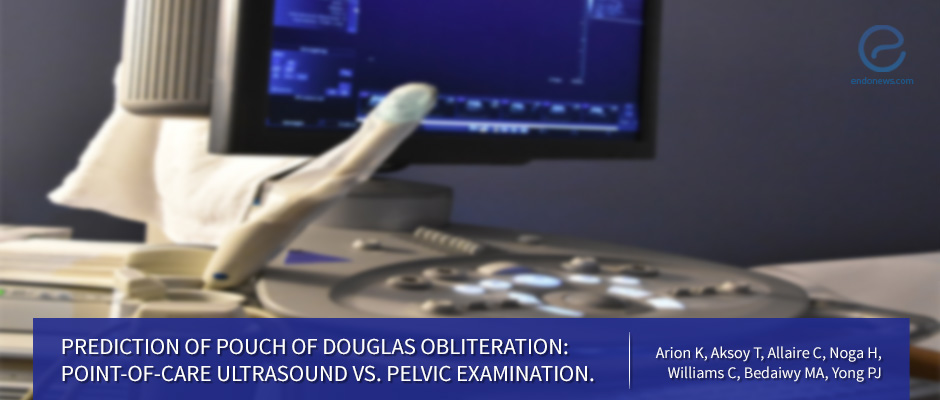Endometriosis involvement of the pouch of Douglas: TVUS vs pelvic exam
Oct 15, 2018
Assessment of Douglas pouch` obliteration via ultrasound
Key Points
Highlights:
- Point-of-care TVUS demonstrated significantly improved sensitivity compared to the pelvic examination for prediction of pouch of Douglas (POD) obliteration.
Importance:
- TVUS may further be assessed as a tool to predict POD obliteration pre-operatively via the absence of the “sliding sign”.
What's done here:
- Women with suspected endometriosis who had a pre-operative pelvic examination and point-of-care TVUS were assessed for POD and were subsequently followed after laparoscopic surgery between August 2015 and December 2016.
Key results:
- The absence of the “sliding sign” detected by point-of-care TVUS demonstrated significantly improved sensitivity (73.3%) compared to palpation of a nodule on pelvic examination (24%) for prediction of POD obliteration.
- This significant difference was seen in women both with partial and complete POD obliteration.
- Amongst the 41 cases with POD obliteration, 66% (27/41) were associated with a discrete DIE nodule; and 34% (14/41), while still being associated with histological endometriosis in the pelvis, were more inflammatory in nature in the absence of a discrete DIE nodule.
- Of those with histologically confirmed endometriosis, the majority (64%,130/202) had Stage I/II endometriosis, while the remaining were Stage III/IV.
- Point of care TVUS sliding sign may improve the pre-operative assessment of POD disease and could be a tool used for optimal surgical planning in women with suspected POD involvement.
Limitations:
- This study was not blinded in terms of pre-operative assessment and surgery.
- Authors did not look at the estimation of uterine mobility on bimanual examination in this study for the comparison to the ultrasound sliding sign.
Lay Summary
Deep infiltrating endometriosis (DIE) can lead to a partial or complete obliteration of the pouch of Douglas (POD). POD involvement has been associated with dyschezia, deep dyspareunia, and increased infertility rates. Assessing the extent of endometriosis involvement of the cul-de-sac allows surgeons to plan an appropriate surgical course to maximize morbidity.
The presence of POD involvement can be assessed through TVUS via a technique known as the “sliding sign” or through a routine pelvic examination. The sliding sign technique assesses whether the posterior cervix-uterus glides freely against the bowel. A negative sliding sign, that means the presence of POD obliteration, is defined by the posterior aspect of the cervix or uterus not sliding freely against the anterior rectum/sigmoid. While both have been postulated to be techniques to assess POD obliteration, no specific study has been published until recently comparing these two in terms of their sensitivity and specificity.
This study published by Arion et. al from the BC Women’s Centre for Pelvic Pain and Endometriosis in The Journal of Minimally Invasive Gynecology included 260 women of whom 15.2% (41/269) had POD (23 with partial and 18 with complete) obliteration and histologically confirmed endometriosis at the time of surgery.
A pre-operative TVUS revealing a negative sliding sign demonstrated a sensitivity and specificity (73.25%, 93.9%) compared to palpation of a nodule on pelvic examination (24.4%, 93.4%) for prediction of POD obliteration. The difference in sensitivity was significantly different via the McNemar test (p<0.001). Not surprisingly, patients who were found to have a negative sliding sign were associated to have longer operating times and requiring further surgery.
Upon pathological examination of samples obtained from laparoscopic excisional surgery, 75.1% (202/269) of patients were found to have at least one excised site with histologically confirmed endometriosis. Of those with histologically confirmed endometriosis, the majority (64%, 130/202) had Stage I/II endometriosis, while the remaining were Stage III/IV.
This sign could be combined with MRI or other sonographic signs to further improve the prediction of the extent and invasiveness of DIE and to maximize the pre-operative prediction of endometriosis to provide a reliable, non-invasive diagnosis for optimizing surgical care, researchers added.
Research Source: https://www.ncbi.nlm.nih.gov/pubmed/30267896
endometriosis TVUS ultrasound DIE pouch of Douglas surgery

